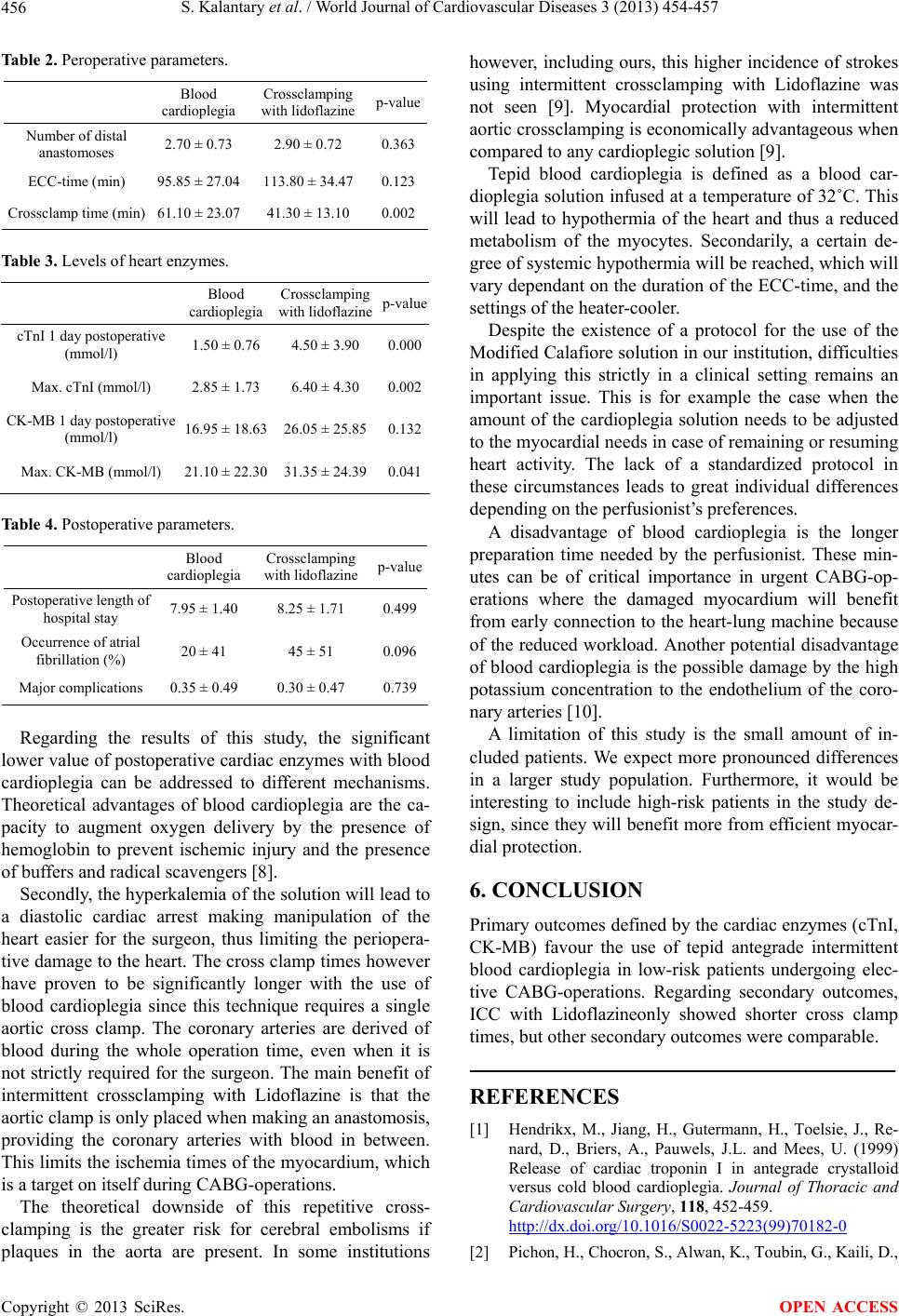
S. Kalantary et al. / World Journal of Cardiovascular Diseases 3 (2013) 454-457
456
Table 2. Peroperative parameters.
Blood
cardioplegia
Crossclamping
with lidoflazinep-value
Number of distal
anastomoses 2.70 ± 0.73 2.90 ± 0.72 0.363
ECC-time (min) 95.85 ± 27.04 113.80 ± 34.47 0.123
Crossclamp time (min) 61.10 ± 23.07 41.30 ± 13.10 0.002
Table 3. Levels of heart enzymes.
Blood
cardioplegia
Crossclamping
with lidoflazinep-value
cTnI 1 day postoperative
(mmol/l) 1.50 ± 0.76 4.50 ± 3.90 0.000
Max. cTnI (mmol/l) 2.85 ± 1.73 6.40 ± 4.30 0.002
CK-MB 1 day postoperative
(mmol/l) 16.95 ± 18.63 26.05 ± 25.850.132
Max. CK-MB (mmol/l) 21.10 ± 22.30 31.35 ± 24.390.041
Table 4. Postoperative parameters.
Blood
cardioplegia
Crossclamping
with lidoflazinep-value
Postoperative length of
hospital stay 7.95 ± 1.408.25 ± 1.71 0.499
Occurrence of atrial
fibrillation (%) 20 ± 41 45 ± 51 0.096
Major complications 0.35 ± 0.490.30 ± 0.47 0.739
Regarding the results of this study, the significant
lower value of postoperative cardiac enzymes with blood
cardioplegia can be addressed to different mechanisms.
Theoretical advantages of blood cardioplegia are the ca-
pacity to augment oxygen delivery by the presence of
hemoglobin to prevent ischemic injury and the presence
of buffers and radical scavengers [8].
Secondly, the hyperkalemia of the solution will lead to
a diastolic cardiac arrest making manipulation of the
heart easier for the surgeon, thus limiting the periopera-
tive damage to the heart. The cross clamp times however
have proven to be significantly longer with the use of
blood cardioplegia since this technique requires a single
aortic cross clamp. The coronary arteries are derived of
blood during the whole operation time, even when it is
not strictly required for the surgeon. The main benefit of
intermittent crossclamping with Lidoflazine is that the
aortic clamp is only placed when making an anastomosis,
providing the coronary arteries with blood in between.
This limits the ischemia times of the myocardium, which
is a target on itself during CABG-operations.
The theoretical downside of this repetitive cross-
clamping is the greater risk for cerebral embolisms if
plaques in the aorta are present. In some institutions
however, including ours, this higher incidence of strokes
using intermittent crossclamping with Lidoflazine was
not seen [9]. Myocardial protection with intermittent
aortic crossclamping is economically advantageous when
compared to any cardioplegic solution [9].
Tepid blood cardioplegia is defined as a blood car-
dioplegia solution infused at a temperature of 32˚C. This
will lead to hypothermia of the heart and thus a reduced
metabolism of the myocytes. Secondarily, a certain de-
gree of systemic hypothermia will be reached, which will
vary dependant on the duration of the ECC-time, and the
settings of the heater-cooler.
Despite the existence of a protocol for the use of the
Modified Calafiore solution in our institution, difficulties
in applying this strictly in a clinical setting remains an
important issue. This is for example the case when the
amount of the cardioplegia solution needs to be adjusted
to the myocardial needs in case of remaining or resuming
heart activity. The lack of a standardized protocol in
these circumstances leads to great individual differences
depending on the perfusionist’s preferences.
A disadvantage of blood cardioplegia is the longer
preparation time needed by the perfusionist. These min-
utes can be of critical importance in urgent CABG-op-
erations where the damaged myocardium will benefit
from early connection to the heart-lung machine because
of the reduced workload. Another potential disadvantage
of blood cardioplegia is the possible damage by the high
potassium concentration to the endothelium of the coro-
nary arteries [10].
A limitation of this study is the small amount of in-
cluded patients. We expect more pronounced differences
in a larger study population. Furthermore, it would be
interesting to include high-risk patients in the study de-
sign, since they will benefit more from efficient myocar-
dial protection.
6. CONCLUSION
Primary outcomes defined by the cardiac enzymes (cTnI,
CK-MB) favour the use of tepid antegrade intermittent
blood cardioplegia in low-risk patients undergoing elec-
tive CABG-operations. Regarding secondary outcomes,
ICC with Lidoflazineonly showed shorter cross clamp
times, but other secondary outcomes were comparable.
REFERENCES
[1] Hendrikx, M., Jiang, H., Gutermann, H., Toelsie, J., Re-
nard, D., Briers, A., Pauwels, J.L. and Mees, U. (1999)
Release of cardiac troponin I in antegrade crystalloid
versus cold blood cardioplegia. Journal of Thoracic and
Cardiovascular Surgery, 118, 452-459.
http://dx.doi.org/10.1016/S0022-5223(99)70182-0
[2] Pichon, H., Chocron, S., Alwan, K., Toubin, G., Kaili, D.,
Copyright © 2013 SciRes. OPEN ACCESS